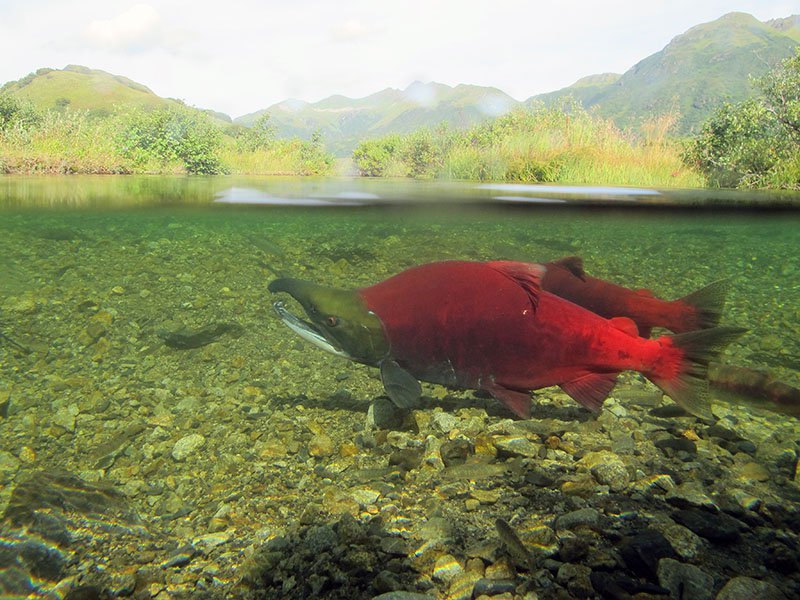With so many salmon fisheries occurring across Alaska each year, why is there always so much hoopla about Bristol Bay?
Sockeye spawners. Alaska Fish & Wildlife Service photo.
It can be summed up in a single word: sockeye.
“The sockeye resource at Bristol bay is unique because of its size,” said Andy Wink, Senior Seafood Analyst at the Juneau-based McDowell Group. “Typically, it’s 35 to 40 percent of the global sockeye supply, and it is a huge chunk of Alaska’s overall salmon value. Preliminary data for 2016 show about 38 percent of Alaska’s total salmon value came out of Bristol Bay, and even more if you add in the Alaska Peninsula.”
The size of the Bay harvest also means it has a big impact on salmon prices elsewhere.
“In 2015, when the base price was 50 cents at Bristol Bay and they had a large harvest, coho prices come way down and sockeye in other areas came down quite a bit too,” Wink explained. “It’s a market moving fishery is the best way to describe it, and that is why it affects so many other Alaska fishermen even if they don’t fish in the bay.”
But that is where a problem arises.
About 44 percent of Bristol Bay’s roughly 1,600 active driftnet permit holders don’t chill their fish.
“That has big ramifications for the overall value of the resource. How much of that value is being left on the table by not chilling?” he asked.
Major processors have put the fleet on notice that they won’t buy from “dry boats” starting in 2018. That’s due to a big shift over several years in the products being sent to markets.
The bulk of the Bay sockeye this year was flown out fresh, either in headed and gutted form (H&G) or as fillets, and not put into lower value cans. Two decades ago, up to 75 percent of the Bristol Bay sockeye catch was canned; today, it’s closer to 25 percent.
“The growth in the Bristol Bay fishery is coming out of fillets and H&G, particularly in the domestic market. But to capitalize on that, the fishery and the processors really need to deliver a quality product,” Wink said. “It bears repeating – the fishermen who close that chilling gap will be the ones who are going to be taken care of more by the processors, because that’s who is feeding their growth.”
Improving fish quality is the mission of the Bristol Bay Regional Seafood Development Association, a non-profit operated for 12 years by drift fishermen and funded by a one percent tax on their catches.
“Lots of people would love to refrigerate but feel their vessel isn’t worth the investment, and the cost for a new vessel is pushing $400,000,” said Mike Friccero of Kodiak, BBRSDA president and 35-year Bay veteran. “The fleet is aging and some guys don’t see the long term pay back for that big investment. So a lot of people are still sitting on the fence.”
The beginning cost for a refrigerated sea water (RSW) system is $30,000 and installation also requires hydraulic overhauls, fish hold modifications and other renovations.
”It’s like saying what’s the cost of remodeling your kitchen. My answer is it depends on who you’re married to,” Friccero said with a laugh.
He added that 35 bay boats have been shipped to Seattle for renovations this year, likely for adding refrigeration and related improvements.
“It’s very hard to get that work done in Bristol Bay and people are building warehouses for anticipated boat improvements to do indoors in the winter,” Friccero said.
In the long run, he believes it’s all worth it.
“The premium for chilling and good handling is as much as 25 cents a pound,” Friccero said. “I think the tide is changing and we are trying to find ways to get traction to make a difference with better fish quality. It’s part of our mission statement and it’s the most important thing we have.”
The preliminary ex-vessel (dockside) value of Bristol Bay sockeye increased 66 percent in 2016 to more than $153 million due to a price increase and strong harvest.
Find the latest sockeye salmon market report at the BBRSDA home page.







